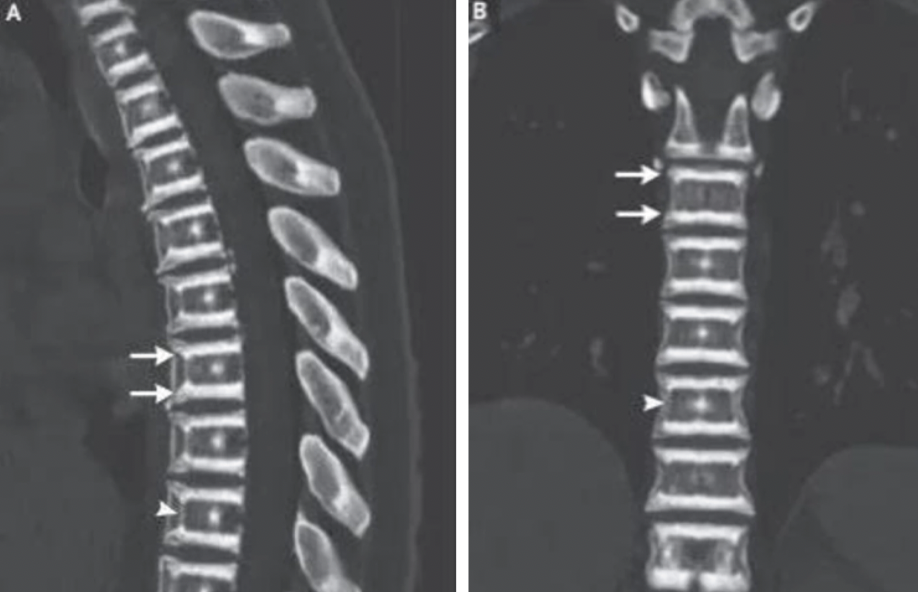Don't ignore back pain: X-rays reveal the importance of seeing a doctor right away
- Replies 32
As embarrassing as it is to admit, most of the time, we tend to ignore and push through the discomfort whenever our backs hurt. We chalk up our backaches to nothing more than a strained muscle from doing household chores, prolonged periods of inactivity, like sitting and reading, or honestly, our age.
Recently, though, shocking pictures were posted online revealing why you should never ignore common pains, especially in your back.

A woman who suffered from back pain for two months had shocking X-ray results. Credit: The New England Journal of Medicine.
According to a report from The Sun, a woman in her late thirties had been experiencing back discomfort and only decided to seek medical attention after two months. Even though she has a history of osteoporosis in her family, it was unclear why she waited such a long time to get the help she needed.
The woman was given a thorough physical examination, and at first, the doctors didn't find anything out of the ordinary. But when they took a number of X-rays, they discovered that she had a medical condition called 'sandwich vertebrae'.
This is a condition in which the thoracic spine has sclerotic bands—this means that the bones have reacted badly to the growing process. Doctors also noticed that she had developed a 'bone inside a bone' as a result of this condition.
Despite the absence of fractures, the woman was nevertheless sent for additional testing, and it was there that doctors discovered that her osteoporosis is unlike anything they'd seen before.
The tests revealed that she had a gene mutation known as autosomal dominant osteopetrosis, or Albers-Schönberg's disease.
Formerly known as 'marble bones’, this condition was initially identified by Albers-Schönberg in 1904, hence the name.
This disorder usually starts in late childhood or early adolescence and causes the bones to calcify, making the skeleton much denser than normal.
As a result, the person is more likely to experience pain and breakages in their bones. Most of the time, the condition is passed down from parent to child, and this is usually the case when an adult is diagnosed with it.

You should have your back checked at the first sign of pain or discomfort. Credit: Stock. (Stock photo)
'Osteoclasts in patients with this condition are unable to resorb bone, which causes bone density to increase, primarily in the spine, the pelvis, and the base of the skull,' said the medical experts at the University Minho School of Medicine.
'The radiographic findings of sandwich vertebrae and bone within bone strongly suggest the diagnosis and should prompt genetic testing.'
Fortunately, the woman was able to acquire the treatment and rehabilitation services she needed. There were no reports of further fractures in her back after a few years, and her condition considerably improved.
Take this as a warning, members: if you've been in pain or discomfort for more than a couple of weeks and over-the-counter medications haven't helped, it's time to make an appointment with your doctor.
Finding the source of pain or discomfort early on can prevent it from worsening into a more serious health problem. Stay safe always, everyone!
Recently, though, shocking pictures were posted online revealing why you should never ignore common pains, especially in your back.
A woman who suffered from back pain for two months had shocking X-ray results. Credit: The New England Journal of Medicine.
According to a report from The Sun, a woman in her late thirties had been experiencing back discomfort and only decided to seek medical attention after two months. Even though she has a history of osteoporosis in her family, it was unclear why she waited such a long time to get the help she needed.
The woman was given a thorough physical examination, and at first, the doctors didn't find anything out of the ordinary. But when they took a number of X-rays, they discovered that she had a medical condition called 'sandwich vertebrae'.
This is a condition in which the thoracic spine has sclerotic bands—this means that the bones have reacted badly to the growing process. Doctors also noticed that she had developed a 'bone inside a bone' as a result of this condition.
Despite the absence of fractures, the woman was nevertheless sent for additional testing, and it was there that doctors discovered that her osteoporosis is unlike anything they'd seen before.
The tests revealed that she had a gene mutation known as autosomal dominant osteopetrosis, or Albers-Schönberg's disease.
Formerly known as 'marble bones’, this condition was initially identified by Albers-Schönberg in 1904, hence the name.
This disorder usually starts in late childhood or early adolescence and causes the bones to calcify, making the skeleton much denser than normal.
As a result, the person is more likely to experience pain and breakages in their bones. Most of the time, the condition is passed down from parent to child, and this is usually the case when an adult is diagnosed with it.
You should have your back checked at the first sign of pain or discomfort. Credit: Stock. (Stock photo)
'Osteoclasts in patients with this condition are unable to resorb bone, which causes bone density to increase, primarily in the spine, the pelvis, and the base of the skull,' said the medical experts at the University Minho School of Medicine.
'The radiographic findings of sandwich vertebrae and bone within bone strongly suggest the diagnosis and should prompt genetic testing.'
Fortunately, the woman was able to acquire the treatment and rehabilitation services she needed. There were no reports of further fractures in her back after a few years, and her condition considerably improved.
Take this as a warning, members: if you've been in pain or discomfort for more than a couple of weeks and over-the-counter medications haven't helped, it's time to make an appointment with your doctor.
Finding the source of pain or discomfort early on can prevent it from worsening into a more serious health problem. Stay safe always, everyone!







